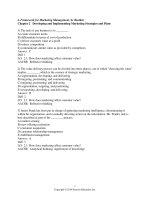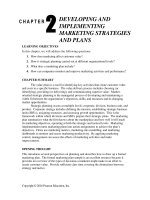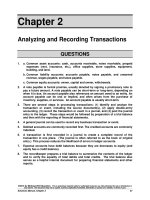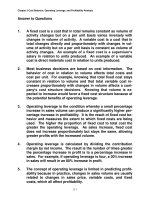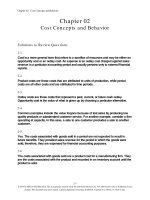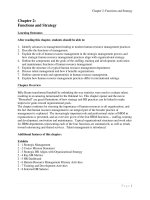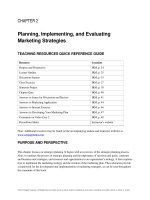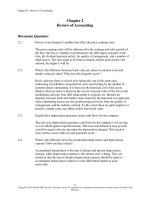Test bank and solution manual for a framwork or marketing management 6e (2)
Bạn đang xem bản rút gọn của tài liệu. Xem và tải ngay bản đầy đủ của tài liệu tại đây (204.18 KB, 8 trang )
CHAPTER
2
DEVELOPING AND
IMPLEMENTING
MARKETING STRATEGIES
AND PLANS
LEARNING OBJECTIVES
In this chapter, we will address the following questions:
1. How does marketing affect customer value?
2. How is strategic planning carried out at different organizational levels?
3. What does a marketing plan include?
4. How can companies monitor and improve marketing activities and performance?
CHAPTER SUMMARY
The value chain is a tool for identifying key activities that create customer value
and costs in a specific business. The value delivery process includes choosing (or
identifying), providing (or delivering), and communicating superior value. Marketoriented strategic planning is the managerial process of developing and maintaining a
viable fit between the organization’s objectives, skills, and resources and its changing
market opportunities.
Strategic planning occurs at multiple levels: corporate, division, business unit, and
product. Corporate strategy includes defining the mission, establishing strategic business
units (SBUs), assigning resources, and assessing growth opportunities. This is the
framework within which divisions and SBUs prepare their strategic plans. The marketing
plan summarizes what the firm knows about the marketplace and how well it will reach
its marketing objectives, operating at both the strategic and tactical levels. Marketing
implementation turns marketing plans into action assignments to achieve the plan’s
objectives. Firms use marketing metrics, marketing-mix modelling, and marketing
dashboards to monitor and assess marketing productivity. By applying marketing
control, management can assess the effects of marketing activities and make
improvements.
OPENING THOUGHT
This introduces several perspectives on planning and describes how to draw up a formal
marketing plan. The formal marketing plan sample is an excellent resource because it
provides an overview of the types of decisions a marketer might make in an effort to
create customer value. Provide sufficient class time covering the distinctions between
strategy and tactics.
Copyright © 2016 Pearson Education, Inc.
ASSIGNMENTS
Students should be encouraged to review selected companies’ annual reports to collect from
these reports the corporations’ mission statements, strategy statements, and target market
definitions. The collected material can be discussed in class comparing the company’s overall
business, marketing, and customer strategies.
Each student is in effect a “product.” Like all products you (they) must be marketed for
success. Have each of your students’ write their own “mission statement” about their career
and a “goal statement” of where they see themselves in 5 years, 10 years, and after 20 years.
Select a local firm or have the students select firms in which they are familiar (current
employers or past employers, for example) and have them answer the questions posed by the
Marketing Memo, Marketing Plan Criteria regarding the evaluation of a marketing plan. Make
sure the students are specific in their answers.
Copyright © 2016 Pearson Education, Inc.
DETAILED CHAPTER OUTLINE
Opening Vignette: Hewlett-Packard has been challenged in recent years, and is an
example of how firms must constantly improve their strategies to adjust to changes in the
marketplace.
I.
Marketing and Customer Value
A. The Value Delivery Process
i. The traditional view of marketing where a firm makes something and
sells it only applies in economies with goods shortages
ii. Marketing is placed at the beginning of business planning in
economies with different consumer needs and wants
iii. Three phases to the value creation and delivery sequence:
1. Choosing the value: homework; market segmentation, target
market selection, value positioning
2. Providing the value: identification of features, prices,
distribution
3. Communicating the value: use the Internet, advertising, sales
force and other communication tools
B. The Value Chain
i. Every firm is a synthesis of activities performed to design, produce,
market, deliver and support its product.
ii. Primary activities
1. Inbound logistics: bringing materials into the business
2. Operations: converting materials into final products
3. Outbound logistics: shipping out final products
4. Marketing (includes sales)
5. Service
iii. Support activities
1. Procurement
2. Technology development
3. Human resource management
4. Firm infrastructure
iv. Firms examine costs and performance in each value-creating activity
and benchmark against competitors to look for ways to improve
v. Core business processes (increasingly reengineered and assigned
cross-functional teams):
1. The market-sensing process: gathering and acting upon
information about the product
2. The new-offering realization process: researching, developing,
and launching new high-quality offerings quickly and within
budget
3. The customer acquisition process: defining target markets and
prospecting for new customers
4. The customer relationship management process: building
Copyright © 2016 Pearson Education, Inc.
II.
deeper understanding, relationships, and offerings to individual
customers
vi. Companies often partner with specific suppliers and distributors to
create a superior value delivery network, or supply chain
C. Core Competencies
i. Three characteristics
1. Sources of competitive advantage that make a significant
contribution to perceived customer benefits
2. Have applications to a wide variety of markets
3. Are difficult for competitors imitate
ii. Accompanied by distinctive capabilities, or excellence in broader
business processes: market sensing, customer linking, channel
bonding
D. The Central Role of Strategic Planning
i. Marketers must prioritize strategic planning in three key areas
1. Managing the businesses as an investment portfolio
2. Assessing the market’s growth rate and the company’s position
in that market
3. Establishing a strategy
ii. A marketing plan operates on a strategic level and a tactical level
1. The strategic marketing plan lays out the target markets and the
firm’s value proposition, based on an analysis of the best
market opportunities.
2. The tactical marketing plan specifies the marketing tactics,
including product features, promotion, merchandising, pricing,
sales channels, and service.
Corporate and Division Strategic Planning
A. Corporate headquarters undertake four planning activities
i. Define the corporate mission
ii. Establish strategic business units
iii. Assign resources to each strategic business unit
iv. Assess growth opportunities
B. Defining the Corporate Mission
i. Over time, the mission may change to respond to new opportunities or
market conditions
ii. Classic questions: What is our business? Who is the customer? What
is of value to the customer? What will our business be? What should
our business be?
iii. Clear, thoughtful mission statements are developed collaboratively
with and shared with managers, employees, and often customers
1. Provides a shared sense of purpose, direction, and opportunity
2. Good mission statements focus on a limited number of goals.
stress the company’s major policies and values, define the
major competitive spheres within which the company will
operate, take a long-term view, and are short, memorable and
meaningful
C. Establishing Strategic Business Units
i. Established using three characteristics
Copyright © 2016 Pearson Education, Inc.
III.
1. Single business or collection of related businesses that can be
planned separately from the rest of the company
2. Own set of competitors
3. Manager responsible for strategic planning and profit
performance and controls most factors affecting profit
D. Assigning Resources to Each SBU
i. Resources assigned using shareholder value analysis; value assessed
on potential of business based on growth opportunities from global
expansion, positioning or retargeting and strategic outsourcing
E. Assessing Growth Opportunities
i. Intensive growth: within current businesses; product-market expansion
grid is helpful
1. Market-penetration strategy: more market share with current
products in current markets
2. Market-development strategy: develop new markets for current
products
3. Product-development strategy: develop new products for
current markets
4. Diversification strategy: develop new products for new markets
ii. Integrative growth: acquire related businesses
1. Use backward, forward or horizontal integrations within the
industry
2. May not reach desired sales volume; challenges with
integration
iii. Diversification growth: identify opportunities for growth from adding
attractive, unrelated businesses
iv. Downsize or divest older businesses: Prune, harvest or divest to
release resources or reduce costs
F. Organization and Organizational Culture
i. A company’s organization is its structures, policies, and corporate
culture, all of which can become dysfunctional in a rapidly changing
business environment.
ii. Corporate culture is “the shared experiences, stories, beliefs, and
norms that characterize an organization.”
iii. Scenario analysis develops plausible representations of a firm’s
possible future using assumptions about forces driving the market and
uncertainties
Business Unit Strategic Planning
A. The Business Mission
i. Develop a specific mission for the strategic business unit
B. SWOT Analysis
i. External Environment (Opportunity and Threat) Analysis: monitor key
macroenvironmental forces
1. Opportunity: area of buyer need and interest that a company
has a high probability of satisfying
a. Offer something in short supply
b. Supply existing product or service in a superior way
i. Problem detection: ask consumers for
Copyright © 2016 Pearson Education, Inc.
suggestions
ii. Ideal method: ask consumers to imagine an
ideal version of the product or service
iii. Consumption chain method: chart steps in
acquiring, using, disposing of product
c. Above methods lead to new product or service
2. Benefit from converging industry trends/introduce hybrid
products or services to the market
3. Make buying process more convenient or efficient
4. Meet the need for more information and advice
5. Customize a product or service
6. Introduce a new capability
7. Deliver a product or service faster
8. Offer product at a much lower price
ii. Market opportunity analysis (MOA) questions
1. Can we articulate the benefits convincingly to the defined
target market(s)?
2. Can we locate the target market(s) and reach them with costeffective media and trade channels?
3. Does our company possess or have access to the critical
capabilities and resources we need to deliver the customer
benefits?
4. Can we deliver the benefits better than any actual or potential
competitors?
5. Will the financial rate of return meet or exceed our required
threshold for investment?
iii. Environmental threat is a challenge posed by an unfavorable trend or
development that, in the absence of defensive marketing action, would
lead to lower sales.
iv. Internal Environment (Strengths and Weaknesses) Analysis
C. Goal Formulation
i. Goals are objectives that are specific with respect to magnitude and
time
ii. Management by objectives meets four criteria
1. They must be arranged hierarchically, from most to least
important
2. Objectives should be quantitative whenever possible
3. Goals should be realistic
4. Objectives must be consistent
iii. Trade-offs include short-term profit versus long-term growth, deep
penetration of existing markets versus development of new markets,
profit goals versus nonprofit goals, and high growth versus low risk.
D. Strategy Formulation
i. Strategy is a game plan for getting what you want to achieve
ii. Porter’s generic strategies
1. Overall cost leadership
2. Differentiation
3. Focus
Copyright © 2016 Pearson Education, Inc.
IV.
V.
iii. Competing firms directing the same strategy to the same target market
constitute a strategic group
iv. There is a distinction between operational effectiveness and strategy:
operationally effectiveness can be copied; strategy develops a unique
and valuable position
v. Strategic alliances complement a firm’s capabilities and resources
1. Product or service alliances
2. Promotional alliances
3. Logistics alliances
4. Pricing alliances
vi. Firms use partner relationship management to form and manage
partnerships
E. Strategy and Implementation
i. Strategy addresses the what and why of marketing programs and
activities
ii. Implementation addresses the who, where, when and how of
marketing programs and activities
iii. Strategy is one of seven elements of business success:
1. Hardware: strategy, structure, and systems
2. Software: style, skills, staff and shared values
The Marketing Plan
A. A marketing plan is a written document that summarizes what the marketer
has learned about the marketplace and indicates how the firm plans to meet its
marketing objectives
B. The most frequently cited shortcomings of current marketing plans, according
to marketing executives, are lack of realism, insufficient competitive analysis,
and a short-run focus
C. Contents of a Marketing Plan
i. Executive summary and table of contents
ii. Situation analysis (relevant background data on sales, costs, the
market, competitors and the macroenvironment)
iii. Marketing strategy (mission, marketing and financial objectives, needs
the marketing offering is intended to satisfy and its competitive
positioning)
iv. Marketing tactics (marketing activities that will be undertaken to
execute the marketing strategy)
v. Financial projections include a sales forecast, an expense forecast, and
a break-even analysis.
vi. Implementation controls: outlines the controls for monitoring and
adjusting implementation; spells out the goals and budget for each
month or quarter so management can review results and take
corrective action as needed.
D. From Marketing Plan to Marketing Action
Marketing Implementation, Control, and Performance
A. Marketing implementation is the process that turns marketing plans into action
assignments and ensures they accomplish the plan’s stated objectives
i. Schedules show when tasks were supposed to be completed vs. when
they actually were
Copyright © 2016 Pearson Education, Inc.
B.
C.
D.
E.
ii. Metrics track actual outcomes of marketing programs to see whether
the company is moving towards its objectives
iii. Two complementary approaches to measure marketing productivity
are:
1. Marketing metrics – assess marketing effects
2. Marketing-mix modeling – estimate causal relationships and
measure how marketing activity affects outcomes
iv. Marketing dashboards are structured to disseminate insights from these
two approaches
Marketing Metrics
i. Set of measures that help marketers quantify, compare and interpret
their performance
ii. Short-term results often reflect profit-and-loss concerns as shown by
sales turnover, shareholder value, or a combination
iii. Brand-equity measures include customer awareness, attitudes,
behaviors, market share, relative price premium, number of
complaints, distribution and availability, total number of customers,
perceived quality, and loyalty and retention
Marketing-Mix Modeling
i. Marking-mix models analyze data from a variety of sources
ii. They help isolate effects, but are less effective at assessing how
marketing elements work in combination
1. Focused on incremental growth instead of baseline sales or
long-term effects
2. Limited integration of metrics related to customer satisfaction,
awareness and brand equity
3. Fails to incorporate metrics related to competitors, trade or
sales force
Marketing Dashboards
i. A concise set of interconnected performance drivers to be viewed in
common throughout the organization
ii. Customer-performance scorecard: how well the company is doing on
customer-based measures
iii. Stakeholder-performance scorecard: the satisfaction of various
constituencies who have a critical interest in and impact on the
company’s performance
Marketing Control
i. Annual-plan control ensures the company achieves sales, profits and
other goals established in its annual plan
ii. Profitability control determines whether to expand, reduce, or
eliminate any products or marketing activities
iii. Efficiency control helps the company look at better ways to manage
marketing spending and investments
iv. Strategic control periodically reassesses the strategic approach to the
marketplace using a marketing audit, which covers the
macroenvironment, task environment, marketing strategy, marketing
organization, marketing systems, marketing productivity, and
marketing functions
Copyright © 2016 Pearson Education, Inc.
